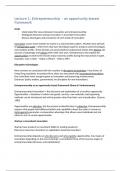Summary
Samenvatting - Innovation & Entrepreneurship (EBM621A05)
- Course
- Institution
Here is my summary of the Innovation & Entrepreneurship course, including lecture notes and figures. Each subject is named by the name of the scientific researchers (what comes up for the exam). The tip is to know the calculation of the NPV well.
[Show more]



